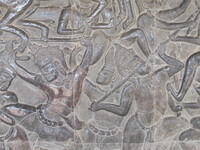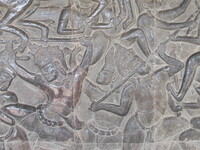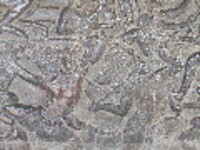| dc.coverage.spatial | Site: Angkor Wat, Siĕm Réab, Cambodia | en_US |
| dc.coverage.temporal | ca. 1113-1177 (creation) | en_US |
| dc.creator | unknown (Cambodian) | en_US |
| dc.date | 1113-1177 | en_US |
| dc.date.accessioned | 2013-09-24T14:49:02Z | |
| dc.date.available | 2013-09-24T14:49:02Z | |
| dc.date.issued | 1113-1177 | en_US |
| dc.identifier | 234897 | en_US |
| dc.identifier.other | archrefid: 2521 | en_US |
| dc.identifier.uri | http://hdl.handle.net/1721.3/142332 | |
| dc.description | Battle of Kurukshetra from the Mahābhārata; combatants; Angkor Wat is a Hindu temple complex at Angkor, Cambodia, built for the king Suryavarman II in the early 12th century as his state temple and part of his capital city. (The Angkorian period dates 802-1432). As the best-preserved temple at the site, it is the only one to have remained a significant religious centre since its foundation--first Hindu, dedicated to the god Vishnu, then Buddhist. Angkor Wat combines two basic plans of Khmer temple architecture: the temple mountain and the later galleried temple, based on early South Indian Hindu architecture. It is designed to represent Mount Meru, home of the devas in Hindu mythology: within a moat and an outer wall 3.6 kilometres (2.2 mi) long are three rectangular galleries, each raised above the next. At the centre of the temple stands a quincunx of towers. Unlike most Angkorian temples, Angkor Wat is oriented to the west (because of its original dedication to Vishnu). The lower gallery (third enclosure) of the temple precinct, barely 5 m wide, is bordered on the outside by a double row of columns. On the inside, however, is a stone wall on which the reliefs are carved running round the entire temple complex. They are about 2 m high and more than 500 m long and cover an area of well over 1000 sq. m. The relief is so shallow that they have been described as "frescoes in stone", and originally they may indeed have been partly painted. A UNESCO World Heritage Site. Source: Wikipedia; http://en.wikipedia.org/wiki/Main_Page (accessed 7/30/2012) | en_US |
| dc.format.medium | sandstone; brick; laterite | en_US |
| dc.rights | © Scott Gilchrist, Archivision, Inc. | en_US |
| dc.subject | architecture | en_US |
| dc.subject | deities | en_US |
| dc.subject | rulers and leaders | en_US |
| dc.subject | Hindu | en_US |
| dc.subject | Buddhist | en_US |
| dc.subject | Khmer | en_US |
| dc.subject | Khmers | en_US |
| dc.subject | Angkorean | en_US |
| dc.subject | Suryavarman II | en_US |
| dc.title | Angkor Wat [site] | en_US |
| dc.title.alternative | Prasat Angkor Wat | en_US |
| dc.title.alternative | Angkor Vat | en_US |
| dc.type | image | en_US |
| dc.rights.access | Licensed for educational and research use by the MIT community only | en_US |
| dc.identifier.vendorcode | 1A2-CB-AW-E8 | en_US |
| vra.culturalContext | Cambodian | en_US |
| vra.technique | construction (assembling), carving (processes) | en_US |
| vra.worktype | historic site | en_US |
| vra.worktype | temple | en_US |
| dc.contributor.display | unknown (Cambodian) | en_US |



